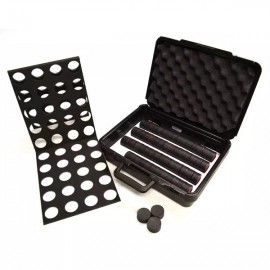Exploring the Minnesota Manual Dexterity Test 探索明尼蘇達手動靈巧測試
Introduction:
The Minnesota Manual Dexterity Test (MMDT) is a widely recognized assessment tool designed to evaluate an individual's fine motor skills and manual dexterity. It has been utilized in various fields, including occupational therapy, rehabilitation, and research. In this article, we will delve into the purpose, administration, and significance of the Minnesota Manual Dexterity Test, shedding light on its role in assessing manual proficiency and its applications in different settings.
Purpose of the Minnesota Manual Dexterity Test:
The primary purpose of the Minnesota Manual Dexterity Test is to measure an individual's ability to perform precise hand and finger movements. It assesses fine motor coordination, dexterity, and speed, providing valuable insights into a person's manual skills. The test is particularly useful in identifying any impairments or limitations in manual dexterity, as well as monitoring progress during rehabilitation or therapy.
Administration and Components of the Test:
The MMDT consists of a series of subtests that require the manipulation of small, peg-like objects within a specified time frame. The test kit typically includes a testing board, a set of pins, a manual, and scoring sheets. The following are the main components of the MMDT:
Placing Test: In this subtest, the individual is required to pick up and place round metal pegs into holes on the testing board, one at a time. The test measures precision and control of hand movements.
Turning Test: This subtest evaluates the ability to rotate round metal pegs 180 degrees and place them back into the holes. It assesses manual dexterity, coordination, and hand-eye coordination.
Displacing Test: The displacing subtest involves moving small, square wooden blocks from one side of the testing board to the other. It measures precision, manual control, and coordination.
Scoring and Interpretation:
The Minnesota Manual Dexterity Test provides objective measurements of an individual's performance. Scoring is typically based on completion time and the number of errors made during each subtest. The results are then compared to established norms for different age groups to determine the individual's manual dexterity level.
Applications and Benefits:
The MMDT has a range of applications across various fields:
Occupational Therapy: Occupational therapists often utilize the MMDT to assess a client's fine motor skills and develop personalized intervention plans. It helps in designing activities and exercises to improve manual dexterity, coordination, and hand-eye coordination.
Rehabilitation: The test is frequently used in rehabilitation settings to evaluate progress and measure the effectiveness of interventions following hand injuries, surgeries, or conditions affecting fine motor skills.
Research: The MMDT is widely employed in research studies to investigate manual dexterity and its relationship to various factors, such as age, gender, neurological conditions, and developmental disorders.
Selection Process: Certain professions, such as dental and surgical fields, may utilize the MMDT as part of their selection process to assess candidates' manual dexterity skills, which are crucial for performing intricate tasks.
Conclusion:
The Minnesota Manual Dexterity Test serves as a valuable tool for evaluating fine motor skills and manual dexterity. Its structured subtests provide objective measurements that help identify limitations, monitor progress, and inform intervention strategies. Whether in occupational therapy, rehabilitation, research, or professional selection processes, the MMDT plays a significant role in assessing and enhancing manual proficiency. By understanding the purpose and administration of the Minnesota Manual Dexterity Test, professionals can effectively utilize this assessment tool to support individuals in improving their fine motor skills and achieving optimal manual dexterity.
介紹:
明尼蘇達手動靈巧測試(MMDT)是一種被廣泛認可的評估工具,旨在評估個人的細微運動技巧和手動靈巧。它在職業治療、康復和研究等各個領域得到應用。在本文中,我們將深入探討明尼蘇達手動靈巧測試的目的、執行和重要性,闡明其在評估手動能力和不同場景應用方面的作用。
明尼蘇達手動靈巧測試的目的:
明尼蘇達手動靈巧測試的主要目的是測量個人執行精確的手部和手指運動的能力。它評估細微運動協調、靈巧和速度,提供有價值的見解,了解一個人的手動技能。該測試特別適用於識別手動靈巧的任何損害或限制,以及監測康復或治療過程中的進展。
測試的執行和組成部分:
明尼蘇達手動靈巧測試由一系列子測試組成,要求在指定的時間內操縱小型的釘子狀物體。測試套件通常包括測試板、一組釘子、手冊和計分表。以下是MMDT的主要組成部分:
放置測試:在這個子測試中,受測者需要將圓形金屬釘子一次放入測試板上的孔中。該測試衡量手部運動的精確性和控制性。
旋轉測試:這個子測試評估將圓形金屬釘子旋轉180度並放回孔中的能力。它評估手動靈巧、協調性和手眼協調能力。
位移測試:位移子測試涉及將小型方形木塊從測試板的一側移動到另一側。它測量精確性、手動控制和協調性。
計分和解讀:
明尼蘇達手動靈巧測試提供個人表現的客觀測量。計分通常基於完成時間和每個子測試中的錯誤次數。然後將結果與不同年齡組別的已建立標準進行比較,以確定個人的手動靈巧水平。
應用和益處:
明尼蘇達手動靈巧測試在各個領域都有廣泛的應用:
職業治療:職業治療師經常使用MMDT來評估客戶的細微運動技巧並制定個性化的干預計劃。它有助於設計改善手動靈巧、協調性和手眼協調的活動和練習。
康復:該測試經常在康復環境中使用,以評估進展並測量在手部受傷、手術或影響細微運動技巧的情況下干預的有效性。
研究:明尼蘇達手動靈巧測試在研究中被廣泛應用,以研究手動靈巧及其與年齡、性別、神經狀況和發展障礙等因素的關係。
選拔程序:某些職業,如牙醫和外科領域,可能在選拔程序中使用明尼蘇達手動靈巧測試,以評估候選人的手動靈巧技能,這對於執行複雜任務至關重要。
結論:
明尼蘇達手動靈巧測試作為評估細微運動技巧和手動靈巧的寶貴工具。其結構化的子測試提供客觀的測量,有助於識別限制、監測進展並指導干預策略。無論在職業治療、康復、研究還是專業選拔過程中,MMDT在評估和提升手動能力方面都發揮著重要作用。通過理解明尼蘇達手動靈巧測試的目的和執行方式,專業人員能夠有效利用這一評估工具,幫助個體改善其細微運動技巧,實現最佳的手動靈巧。


